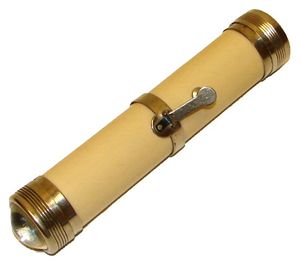 Image via Wikipedia
Image via WikipediaWhen D cell batteries became commercially available in 1896, it opened the door for all kinds of battery-powered inventions. One was the “electrical hand torch,” introduced in 1898 by the American Electrical Novelty and Manufacturing Company, which would later change its name to The American Ever-Ready Company. The first lights were paper and fiber tubes, with a carbon filament bulb covered by a lens on one end, two D batteries inside, and a metal ring on the side. Pressing down on the ring caused it to hit two metal poles—one positive and one negative—which completed the electrical connection, lighting up the bulb. (click below to read more)
Early batteries were quite weak, though, so the light only came on in brief flashes before going out again, which is how they got their nickname, “flashlights.” Heavy use of the light also meant that it had to be “rested” so that the batteries could recharge. Still, it was much better than carrying a candle that could go out, a lantern that had to be refilled with oil, and, more importantly, there was no chance of starting a fire.
As battery and filament technologies improved, the flashlights could stay on for minutes at a time, but the name had already become synonymous, so it stuck (in America and Canada anyway; the rest of the world still calls them “torches”).
While the lights were fairly popular, sales really skyrocketed in 1898 when Ever-Ready donated their new and improved metal flashlights to the New York City Police Department. When officers reported how useful the lights were in their duties, these testimonies were included in the company’s product catalog, adding weight to the quality and usefulness of the brand.

No comments:
Post a Comment